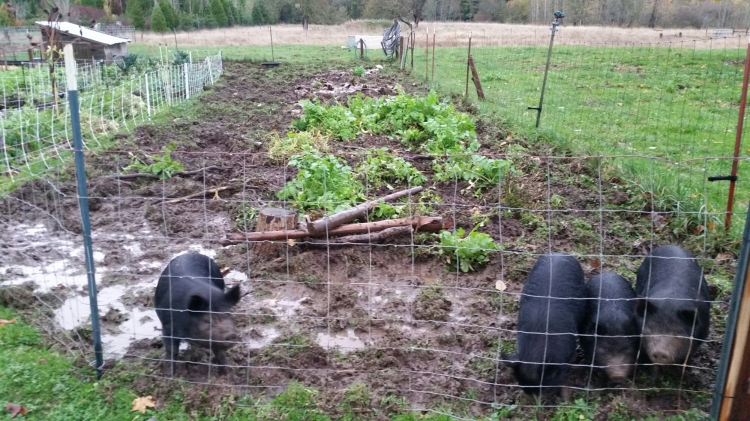As the summer ended, we felt that we knew the homestead pretty well. We knew where the pasture was thick and healthy, and we knew where it transitioned into sedge–an indicator of a low area. We had a mental map of the labyrinth of electric fence wire in the pastures, and how to direct current from one to the other. We learned that our fields are full of many weeds, ranging from the “friendly weeds,” like stinging nettle and comfrey, to annoying but benign buttercup and thistle, to my nemesis morning glory (also known as bindweed and “damn moonflower.”)
We knew which apple trees bore first, which were best for cider, and which ones we need to cut down this winter. We knew where to keep on top of the blackberry that encroaches the perimeter.
And we took passing mental note of these odd ankle-twisting ditches that snake through the yard, garden, and pasture…
Almost seven and a half inches of rain later (in October alone), Bellfern Homestead is suddenly an alien landscape. A lake appeared in our back pasture (the photo at the top). The groundwater level rose so high that it flooded our septic tank, which emitted a panicked buzzer when it couldn’t pump fast enough to deal with the inflow. And those mysterious ditches now run with water, shunting it away from our driveway and directly into our summer pig paddock, which transitioned quickly from hard-packed dirt to 8-inch deep mud so sticky that even the pigs don’t want to walk through it.
I know that every children’s book shows pigs happily rolling in mud, but omnipresent mud is not a healthy environment for a pig. Mud harbors parasites, and can cause infections on feet and bellies that never dry.
To get the pigs out of the destroyed paddock, we moved them into our vegetable garden, which was mostly done for the season and ready to be tilled under anyway. The pigs made quick work. The whole garden was completely tilled under in 1 week, and every bit as muddy as the paddock they had just evacuated.

Which brings us to the dilemma of the week. We had planned to raise these pigs for about a year, up to around 120 lbs (American Guinea Hog are a very small breed). They’re all around 70-80 lbs now and growing slowly. But the ground is so soft that every time we move them to fresh green pasture, they destroy it much faster than it can regenerate, leaving lots of open muddy areas where weeds will germinate. We’re not sure that our pastures can support these pigs over the winter, but the pigs aren’t yet big enough to sell to customers, and they’re also not big enough to justify the expense of butchering.
I don’t remember what kept me up at night when I lived in the city. Was it my job? Was it planned house renovations? Now, I lay awake wondering if I want to learn to butcher a pig from a YouTube video, and if I’m brave enough to try it. And I worry that the coyote scat out in the field is getting closer and closer to the house and animals. And that the pigs will get sick from the wet or mud before we can even eat them. I could go on.
But I won’t. There’s always more than one narrative, and I can choose which one to tell. This week, I’m choosing the narrative of blessed abundance. We have an abundance of food security, water, and space. We have good neighbors and good friends. We have short days and long evenings indoors snuggled under fuzzy blankets and fluffy dogs. From this perspective, winter is good.



I think you could do the butchering. It’s the knocking I can’t handle. But I think it’s also a good sign of our humanity being intact. It really shouldn’t be a morally “easy” task.
I didn’t realize that anyone’s farm was as wet as ours! At least the ducks like it!!
LikeLiked by 1 person
I absolutely agree, butchering and hunting shouldn’t be “easy.” But animals feed us, and I’m grateful. Do you ever do workshops on AGH butchering? I would really love to see this done in person and have an opportunity to ask questions before I take it on.
LikeLike
I really look forward to your post, you both write well. I hear you on the narrative choice. I grow avocados in San Diego and would love the rain. Until the trees started falling over and hill slides and roads washed out… So stay positive, keep sharing your story and I look forward to the next update.
LikeLike
Thank you Kurt!
LikeLike